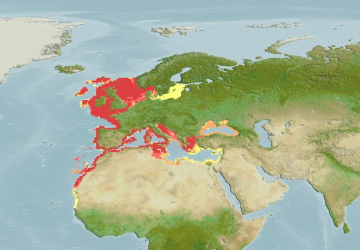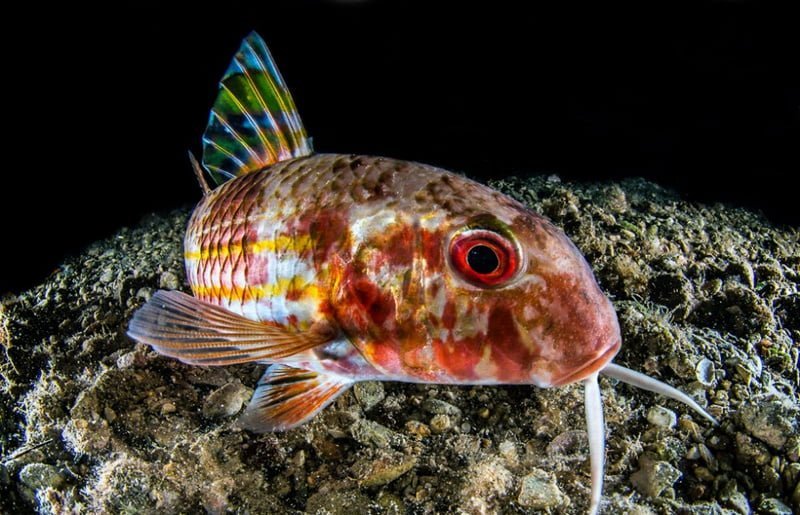Mullus Surmuletus
– Striped Red Mullet –


| Conservation status |
|---|
 Least Concern (IUCN 3.1)[1] |
| Scientific classification |
Mullus surmuletus Linnaeus, 1758
| Kingdom: | Animalia |
| Phylum: | Chordata |
| Class: | Actinopterygii |
| Order: | Perciformes |
| Family: | Mullidae |
| Genus: | Mullus |
| Species: | M. surmuletus |


The striped red mullet or surmullet (Mullus surmuletus) is a species of goatfish found in the Mediterranean Sea, eastern North Atlantic Ocean, and the Black Sea. They can be found in water as shallow as 5 metres (16 ft) or as deep as 409 metres (1,342 ft) depending upon the portion of their range that they are in. This species can reach a length of 40 centimetres (16 in) SL though most are only around 25 centimetres (9.8 in). The greatest recorded weight for this species is 1 kilogram (2.2 lb). This is a commercially important species and is also sought after as a game fish.[2]
Mullus barbatus and it are commonly called “red mullets” and often are not distinguished, though they can be told apart by the striped first dorsal fin of M. surmuletus.
Despite its English name, the striped red mullet, of the goatfish family Mullidae, is only very distantly related to the grey mullet and other species called “mullet“, classified in a different family of the order Perciformes.
Description
The body is slender , cylindrical, laterally compressed, with large scales . Two dorsal fins, the first of which has 8 spines and is marked with brown and yellow bands .
The head is quite large with an elongated profile and has two chin barbels which can fit into a gutter.
The mouth is in a subterminal position and small, slightly protractile *.
The caudal fin is distinctly concave and yellow in color.
In diving, the general color is pinkish beige with a darker lateral line (by day), more clearly red and marbled at night., also when the fish are on bedrock. The juveniles, pelagic *, are bluish.
This fish can reach a maximum size close to 40 cm for a weight of about 1 kg. On average, in the area frequented by divers, fish of 15 to 25 cm are the most abundant, the large individuals rather frequenting the area of 80 to 100 m.
Biotope
Despite its name of red mullet , Mullus surmuletus is more frequently encountered on soft bottoms : sand, gravel, eelgrass or posidonia meadows . However, it does not hesitate to venture into the vicinity of the rocks, seeking food using its two characteristic barbels.
It can often be spotted from afar by the cloud of sediment that its “bulldozing” activity does not fail to raise.
After its passage, large “quarries” of vaguely elliptical shape remain visible.
Similar Species
Mullus barbatus , the red mullet , has a straighter profile than its “rock” cousin and has three small scales under the eye (only 2 in M. surmuletus )
Its first dorsal fin is colorless (marked with yellow and brown bands at M. surmuletus )
It is hardly ever encountered by divers (lives on muddy bottoms in the 100/200 m zone)
Pseudupeneus prayensis , the West African red mullet , can coexist with Mullus surmuletus in the Canaries, on the Moroccan coasts and in the Alboran Sea. It is frequently found on the stalls of European fishmongers, where it is marketed under the name “Senegal mullet”. Its first dorsal is uniform in color, it has a small black spot behind the eye and 6 to 8 small scales under the eye.
Two other translessepsian “barbets” (originating from the Red Sea) now frequent the eastern basin of the Mediterranean, belonging to the genus Upeneus.
Upeneus pori , strip- tailed barbet and Upeneus moluccensis , the golden-banded barbet, fairly easy to distinguish from mullids by their striated caudal fin and their dorsals marked with dots or streaks.
Alimentation
Adult individuals feed on worms, crustaceans, molluscs which they flush out in the sediment, the young on copepods, amphipods, and small crustaceans. The larvae *, pelagic, of zooplankton * (copepods and larvae of crustaceans)
Reproduction
From April to June in the Mediterranean and in the Bay of Biscay, the eggs are pelagic, hatching takes place 3 to 8 days later depending on the temperature. The planktonic life of the larvae lasts about five months.
On their arrival at the coast (September-October in the Mediterranean, August in the Atlantic) the young lose the blue color which allowed them to pass relatively unnoticed in the plankton to adopt the beige-pink livery of the adult.
Associated Life
It is frequent to meet associations, more or less permanent, between red mullet, labrids, sparids and flatfish.
The digger’s work carried out by red mullet flushes out a number of invertebrates that are too small or too mobile to interest them, but which are the joy of profiteers of all kinds … sorry, of all scales!
This type of association is found in practically all species of mullids, tropical or not, whose feeding behavior is almost identical.
Various Biology
The estimated lifespan is 10/11 years, sexual maturity about 2/3 years.
The main predators (apart from humans!) Are carnivorous fish: bars , places , barracudas , conger eels , anglerfish and sharks.
Further Information
A slow and careful swim, close to the bottom, makes it quite easy to approach the groups of red mullet busy digging the sediment. Even easier approach at night where red mullet sometimes sleep in groups in the seagrass beds, sporting a characteristic marbled livery.
The rock barbet mullet is a species of high commercial value , highly sought after.
It is caught by trawl and especially by gillnet, in the Mediterranean as in the Atlantic.
Annual catches declared in France are around 700 tonnes (red mullet and mud combined), which has been falling steadily for several years, which is partially offset by imports of tropical species.






















































































































































































































































































































































































